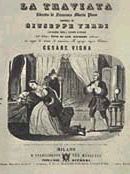Behind the scenes of Verdi's great operas
Giuseppe Verdi is arguably the best-loved composer of all time. In this the centenary of his death we take a look at the making of some of his greatest works - Nabucco, Aida, Rigoletto and La Traviata
 Nearly 30 passed between the first performance of Verdi's Nabucco and the premiere of Aida. By that time the promising debutant from Roncole (Parma) had become one of the greatest living composers in the world.
Nearly 30 passed between the first performance of Verdi's Nabucco and the premiere of Aida. By that time the promising debutant from Roncole (Parma) had become one of the greatest living composers in the world.When Verdi's first opera Oberto met with some success in 1839 the future looked bright for the young musician. However the following years, spent between his home in Roncole and the high life in Milan, were fraught with personal, financial and work problems.
Nabucco was his big chance - and Verdi grabbed it, hiring only the best singers and following every stage of preparations. He fine-tuned the arias stretching his singers to their very limit and added the depth and personality to his characters that reflected the mood of the time (we're in full Risorgimento). The opening night of the opera in La Scala on September 9th was a huge success. Verdi was the toast of Milan and everything, from sauces to hats bore his name.
Nabucco was just the beginning. His success as an artist matched his money-making capacities (not to be sniffed at) and culminated with one of his most popular works, Aida. The opera was commissioned to celebrate the opening of the Suez Canal - Verdi was chosen over his rival, the German composer, Richard Wagner. The opera confirmed his position as a world class composer and the first nights in Cairo (December 24th, 1871) and Milan (February 8th, 1872) were nothing short of triumphant.
 In the meantime, however, like most inhabitants of the Po valley, Verdi had a strong work ethic instilled in him and, rather than rest on his laurels following the success of Nabucco, he set back to work, composing, editing and travelling about Europe. In the second half of the century he wrote Rigoletto. The opera, based on Victor Hugo's story "Le Roi s’amuse" was a long time in production mainly because of the censorship problems of the original. Indeed when Hugo's book was first published in 1832 it was widely condemned for its licentious content and although 20 years had passed it was still something of a hot potato. Verdi was indignant at the censors' proposals but, with the help of his trusted librettist, Francesco Maria Piave, he managed to change the names and locations sufficiently to please the authorities. And, in true Verdi form Rigoletto opened to standing ovations in the Fenice Opera House in Venice.
In the meantime, however, like most inhabitants of the Po valley, Verdi had a strong work ethic instilled in him and, rather than rest on his laurels following the success of Nabucco, he set back to work, composing, editing and travelling about Europe. In the second half of the century he wrote Rigoletto. The opera, based on Victor Hugo's story "Le Roi s’amuse" was a long time in production mainly because of the censorship problems of the original. Indeed when Hugo's book was first published in 1832 it was widely condemned for its licentious content and although 20 years had passed it was still something of a hot potato. Verdi was indignant at the censors' proposals but, with the help of his trusted librettist, Francesco Maria Piave, he managed to change the names and locations sufficiently to please the authorities. And, in true Verdi form Rigoletto opened to standing ovations in the Fenice Opera House in Venice.Possibly influenced by Rigoletto, or inspired by his own love affair with Giuseppina Strepponi, Verdi writes La Traviata, based on another delicate story this time by Alexandre Dumas, "La Dame aux camélias". La Traviata was an unprecedented flop. In hindsight the singers were unable to sustain the dramatic intensity of the opera and Verdi set to work editing out characters and honing the plot. The next performance of La Traviata, on May 6th, 1854, featured an entirely new cast and was Verdi's greatest success to date.
Rigoletto, La Traviata, Aida, Nabucco and Il Trovatore are currently in programme until September 2nd at the Arena (Verona).